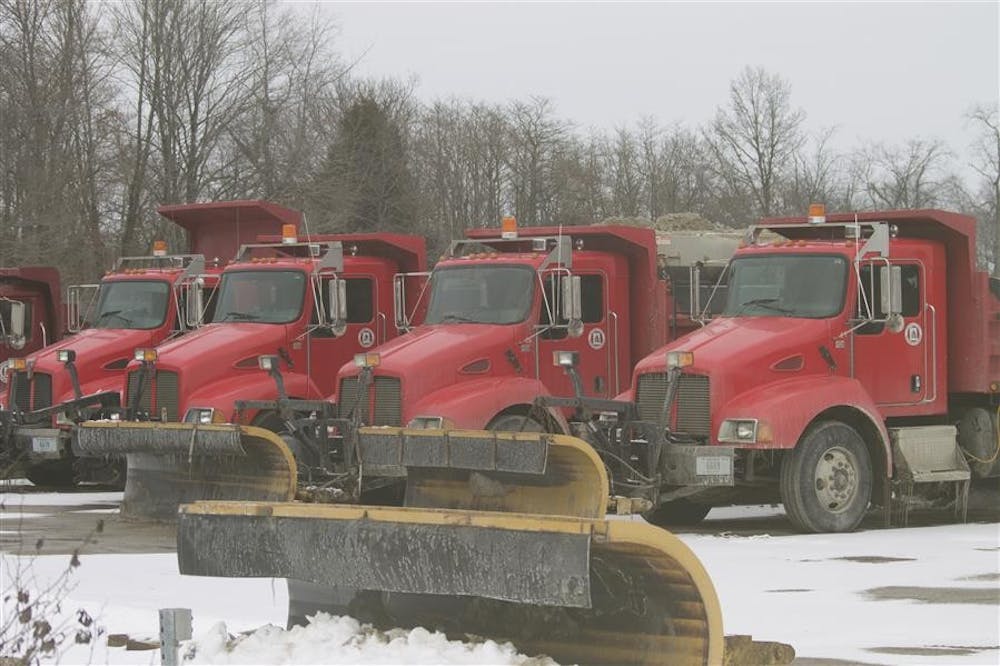Editor’s note: Some sources’ names were omitted to protect their identities.
As the ice and snow began to accumulate on the streets of Bloomington the last weekend of February, city and county plow drivers arrived at work. While much of the community slept, they drove their trucks, salting the pavement and clearing roads.
The storm started with heavy ice and got worse with about 4 inches of snow, more than a usual late-winter storm but far from the worst this season, according to data from the National Weather Service.
By the end of their shifts, some drivers had worked more than 20 hours behind the wheel of one-ton trucks on icy roads in rough conditions.
These long hours are common for Monroe County and Bloomington plow drivers, especially during record-setting winters like this one. Spending more than half a day clearing streets helps make roads safe for other drivers, but plow operators and their supervisors said long hours cause potentially dangerous levels of fatigue.
And while John Chambers, county highway superintendent, said he hasn’t seen a fatigue-related accident, long shifts are still cause for worry.
“I have been behind the wheel of a truck for 48 hours straight without taking a break,” he said.
That shift was in the 1970s, near the beginning of his 39 years with the county.
“First of all, we don’t want something to happen to one of our people or one of our citizens,” Chambers said. “Second, we’re very cognizant of liability issues.”
***
Chambers commands a team of 28 drivers and six mechanics. He’s the one responsible for ensuring county roads are cleared and his employees are safe.
For any given storm, his crew will cover 705 miles of road, everything in Monroe County except Bloomington and Ellettsville, which have their own fleets.
On the busiest days, his plow drivers often clock more than 20 consecutive hours including breaks, according to highway department data. In the past two years, drivers have worked 12-hour or longer shifts at least 11 times. Their longest shift was last December — 25 hours.
“There are absolutely safety concerns,” Chambers said. “It’s a long time.”
Chambers said he tries to ensure his plow drivers avoid fatigue, ideally letting them take breaks after 12 to 16 hours.
A break could mean returning to the garage or pulling over on the side of the road, but either way it usually involves sleeping in the cab of the truck.
But that goal isn’t always accomplished.
Special circumstances can dictate longer times behind the wheel. For example, an IU men’s basketball game might require additional plowing to make sure long lines of fans can get home safely.
Some plow operators choose not to take a break, even after hours of driving. One driver, who agreed to be interviewed on the condition that his name not be published, said he often keeps driving rather than pulling over.
“If it’s bad enough, I’ll keep going,” said the driver, who has 15 years of experience. “A lot of them are like me. They don’t stop because they want to get done.”
Inside city limits, drivers can face even longer hours behind the wheel.
Street Operations Director Joe VanDeventer’s crew of 28 drivers cover everything in Bloomington city limits, 237 miles of roads with heavy traffic.
Though he said he tries to give drivers breaks to minimize fatigue, there are days when clearing streets comes first. And even when drivers need to rest, the best time for a break — often the middle of the night — is exactly when the crew can most effectively clear streets because there is less traffic.
“We try to not keep them out more than 24 hours,” VanDeventer said. “It’s not always possible.”
***
If the city and county were private trucking companies, like the ones that transport 18-wheel semi-trucks full of goods across the country, their drivers would be bound by a long list of regulations.
In most situations, holders of commercial driver’s licenses are limited to 10 or 11 hours behind the wheel at any given time. After that, they’re required to rest or go off duty for at least 10 hours, according to the Federal Motor Carrier Safety Administration.
Additionally, drivers for commercial carriers have to keep detailed, up-to-date logbooks that prove they’re following these strict regulations.
This is not the case with city and county employees, said Darryl Brane, who works with the Indiana State Police division responsible for enforcing commercial vehicle regulations.
“The federal government has exempted any type of government employees,” he said. “It’s years in the making.”
Just because long shifts are legal doesn’t mean they’re safe.
The plow driver with 15 years of experience said he has felt himself starting to drive off the road before when fatigue set in after hours on the road. Another driver who spoke on the condition his name wouldn’t be published said in his 23 years plowing for the county he hasn’t had any accidents, but he’s worried he will.
“I don’t want to hit some car with some kids in it,” the driver said.
He said he’s worried that because plow drivers carry commercial driver’s licenses, which require those strict regulations, an accident could lead to a lawsuit.
“Ken Nunn would love it if we had too many hours,” he said, referring to the Bloomington lawyer. “If I have a wreck, I don’t want to lose everything I’ve worked my whole life for.”
***
Finding a solution is difficult. At all levels of government, money is tight.
Each year, Chambers takes budget requests to the County Council. The council rarely denies him, he said, but he’s mindful of what they’re likely to fund.
Last winter, the county spent $91,278 on labor, according to documents obtained from the County Highway Department. By Feb. 16, this winter had already cost $182,880 for driver and mechanic wages.
Though overtime pay is costly, Chambers said it could be more expensive to add new drivers because of the need to pay benefits and the fact that his fleet of trucks is big enough only to accommodate the current crew.
The Bloomington Streets Department can pull in reserves from the Sanitation and Utilities departments to swap out some of its drivers if they need to, VanDeventer said.
“It’s kind of unusual,” he said. “This year I think we’ve done it two or three times.”
This winter set records in central Indiana, according to the National Weather Service. More than 52 inches of snow meant thousands of man hours of plowing for Bloomington and Monroe County.
At least two plows — one operated by the City of Bloomington and one by the Indiana Department of Transportation — have had accidents in the surrounding area in the last two months. Though neither appears to have been caused by fatigue, VanDeventer said the balance between the safety of snow-free streets and the risk of tired plow operators is of constant concern in the winter months.
“That’s what we juggle every time,” he said.
Follow reporter Michael Auslen on Twitter @MichaelAuslen.
Snow plow drivers working 24-hour shifts
No accidents yet, but county and city supervisors say drivers’ long hours are potentially dangerous

Get stories like this in your inbox
Subscribe





